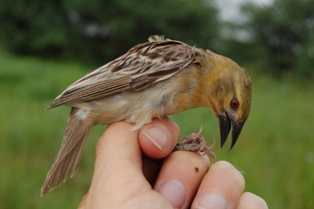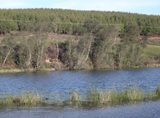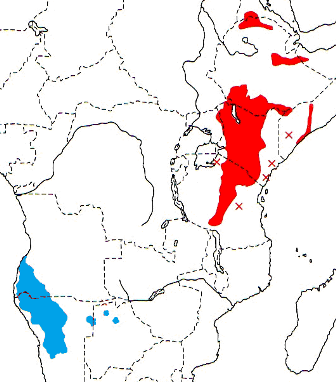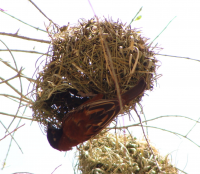Weaver news

 The Chestnut Weaver Ploceus rubiginosus is named after its colour. The adult male (photo above left) in breeding plumage is a distinctive chestnut with a black head. There are 2 other chestnut coloured birds in Africa. The Cinnamon Weaver P. badius (see photo here) is similar but has yellow wing edges (rather than pale) and yellow vent (rather than brown as in the Chestnut Weaver). The Chestnut Sparrow Passer eminibey has chestnut wing edges and is smaller than the Chestnut Weaver. Female (photo above right) and non-breeding male Chestnut Weavers are much browner than other weavers, with buff or chestnut breast-band and flanks, and in southern Africa the grey bill is distinctive. Juveniles are similar but with streaked breasts (see photo here). Chestnut Weavers inhabit dry thornveld.
Two subspecies of the Chestnut Weaver are currently recognised (see map left, based on Birds of Africa):
The Chestnut Weaver feeds on grass seeds and also on insects. In East Africa it feeds mainly on wild grass seeds but switches to cereal crops (especially sorghum) in Feb-Apr, and thus being a pest. Non-breeding birds flock and roost with other granivores and may form large mixed roosts. This species is monogamous and polygynous and highly colonial, with 500 or more nests covering trees in a small area (photo below left, from phown 3739). For example, following exceptional rains in Namibia, over 100 trees had 40-100 nests in each. Colonies are established at different sites every year, although sometimes the same sites are used again in Namibia. Breeding is fairly well-synchronized within a colony. Males are present during the nest-building phase, displaying with beating wings from their nests. Males leave the colony during the breeding cycle, often while the females are incubating. The males form nomadic flocks and start moult, leaving colonies occupied only by females and young birds.
The nest is built by the male of grass stems (photo right, from phown 2476). The nest is retort-shaped with a short spout (sometimes absent). Nests are usually suspended from the tip of branches, sometimes 3-4 nests hang in a string below one another or are clustered together. Nests look untidy, having protruding grass stems. The nest ceiling and floor are lined with grass heads. Females do all the incubation and feeding of young, since the males leave the colony early. Red-headed Finches and other species often nest in old nests, and Red-headed Finches also take over active nests. There are 74 PHOWN records (see PHOWN summary), all but one being of the southern subspecies. Many more PHOWN records are needed every year to study how colony locations vary annually. Also look out for other bird species using their nests. Submit any weaver nest records to PHOWN (PHOtos of Weaver Nests) via the Virtual Museum upload site. PHOWN summary Previous Wedn: Grey-headed Social Weaver Full weaver species list |













